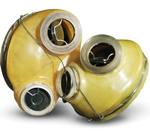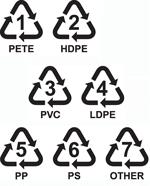How to Eat Less Plastic
Each of us might ingest up to a credit card’s worth of plastic weekly through food and water. Here, how to minimize exposure.

The first company to ever sell fully synthetic plastic—the Bakelite Corp., established in 1922—advertised it as “The Material of a Thousand Uses.”
It had that right: Today, beyond the plates we eat from, the straws we drink through, the furniture we sit on, and the toys our kids play with, there is plastic in the clothes we wear, in the cars we drive, even in the lifesaving medical equipment in our hospitals. And—more than anywhere else—plastic is in our packaging, encasing everything from laundry detergent to prescription pills, from the food we eat to the beverages we drink.
In fact, the world has produced more than 10 billion tons of the stuff, mostly since the 1950s, and we just keep making more. In 2018, manufacturers created almost 400 million tons of new plastic, and production is expected to almost quadruple by 2050. The vast majority of that plastic eventually ends up piled up around the planet. Some of it may last for hundreds of years, and when it does break down, it can become small particles of plastic—microplastics—that spread farther across the planet, entering our water and food supply.
(Find out how to use less plastic and see the Plastic Through the Ages timeline, below.)
Why is this a problem? After all, manufacturers and certain regulatory agencies have long assured us that plastics are safe for human health. “In the U.S., we have a robust system that looks at materials that are in contact with food, and that includes plastics, managed by the [Food and Drug Administration],” says Karyn Schmidt, senior director of regulatory and technical affairs at the American Chemistry Council, an industry group that represents plastics and chemical manufacturers. “Consumers should feel very confident using any plastic coming into contact with food that they would buy in a grocery store.”

Photo: Ines Dieleman / Trunk Archive Photo: Ines Dieleman / Trunk Archive
The Menace of Microplastics
Any plastic item—bag or bottle, toy or chair—starts to come apart with use and time, breaking down into tinier and tinier fragments. Most of the plastic produced hasn’t been recycled (see “What’s Gone Wrong With Recycling”). But it’s not just old plastic that has disintegrated into particles that make their way into lakes, rivers, and oceans. Cracking open a brand-new plastic bottle or tearing a wrapper off a sandwich releases fragments of plastic that we might end up ingesting. Household dust can be full of microplastics—and it’s possible that you might kick this up into the air from your carpet and breathe it in. Plastic fibers even wash off clothes into our water supplies.
Fragments of plastic smaller than 5 millimeters in length are known as “microplastics,” and scientists have started to refer to even more microscopic fragments—generally smaller than 1,000 nanometers—as “nanoplastics.” In a 2019 report, the World Health Organization found that we’ve unknowingly ingested microplastics for decades without clear negative consequences, saying that research into potential health effects is needed. While there’s much we don’t yet know, we have learned that micro- and nanoplastics are everywhere. Snow in the Arctic carries substantial amounts of microplastic, according to a 2019 study in the journal Science Advances, and even more has been detected in the Alps. Microplastics can even be found in the seemingly pristine sand of Hawaiian beaches.
Given this, researchers are concerned that these plastics can make their way into the tissues of our bodies, according to Linda Birnbaum, Ph.D., the recently retired director of the National Institute of Environmental Health Sciences (NIEHS) and the National Toxicology Program. “Nanoplastics can easily cross all kinds of barriers, whether it’s the blood-brain barrier or the placental barrier, and get into our tissues,” Birnbaum has said. Breathing in nanoplastics might introduce them into our cardiovascular system and bloodstream, for example.
It’s also possible that nanoplastic particles might create a systemic inflammatory response, according to Phoebe Stapleton, Ph.D., an assistant professor of pharmacology and toxicology at Rutgers University in New Brunswick, N.J. Her research has previously shown that inhaled metal particles can harm the cardiovascular health of a developing fetus. And her animal research has also confirmed that when a mother breathes in nanoplastics, the particles can be found in many places inside the fetus. “We know that after exposure, the plastic particles are everywhere we look,” Stapleton says. “We don’t know yet what those particles are doing once they’re deposited there.” Other researchers, like Myers at Environmental Health Sciences, are concerned that nanoplastics could possibly release harmful chemicals (such as BPA) into our bodies.
Another area of inquiry focuses on the fact that microplastics act like magnets for additional toxins, picking up pollutants such as polychlorinated biphenyls (PCBs), chemicals now banned from manufacture in the U.S. but still present in the environment. According to Linda Birnbaum, formerly at the NIEHS, if we later ingest or inhale contaminated microplastics, they may release these substances they’ve picked up into our blood or organs, along with whatever chemicals are also in the plastic itself.
A Trail of Chemical Harm
No matter what new information scientists discover about the potential danger from microplastics, we already have sufficient evidence that the chemicals found in various plastics can have serious adverse effects on our health, says Leonardo Trasande, M.D., director of the Center for the Investigation of Environmental Hazards at New York University and the author of “Sicker, Fatter, Poorer” (Houghton Mifflin Harcourt, 2019), a book about endocrine-disrupting chemicals.
“What we know raises serious red flags about chemicals used in plastic containers,” he says. They affect brain and organ development in children, and are linked to infertility and cardiovascular problems. Around 10,000 adult men die from cardiovascular disease linked to phthalates every year, he says.
There’s essentially no limit to the types of plastic that can be produced from thousands of types of chemicals, leading to products that range from flimsy high-density polyethylene grocery bags to bullet-stopping Kevlar. These chemicals are added to different plastics to give them various properties. Most people are familiar with better-known villains, such as BPA, which has been used since the 1950s to make hard, clear plastic like that used for some beverage bottles. But many other chemicals in plastics have been linked to serious health effects, including other bisphenols (in the same family as BPA), phthalates, and styrene. These chemicals can seep from packaging into food and then into the human body, Trasande says.
The shape and structure of chemicals such as BPA and phthalates cause them to interfere with the endocrine, or hormonal, system, which is why they're known as endocrine disrupters. Tiny amounts of hormones, measured in parts per billion or even per trillion, affect the function of a wide range of systems throughout our bodies. And that’s what makes even a low dose of BPA or these other endocrine disrupters a focus of medical concern.
Bisphenols are thought to affect reproduction; some experts have suggested a link to the significant decline in sperm count in high-income countries over the past few decades. But there is also concern that they may affect brain development and the immune system, and can increase obesity and cancer risk—especially cancers influenced by the endocrine system, such as mammary and prostate cancer, says Laura Vandenberg, Ph.D., an associate professor at the University of Massachusetts Amherst School of Public Health and Health Sciences. Phthalates are also known to disrupt hormones, and prenatal exposure to phthalates is associated with lower testosterone in male offspring. Styrene, another chemical found in plastic and food packaging, has been linked to nervous system dysfunction, hearing loss, cancer, and more.
“BPA is the poster child for these types of chemicals,” says Patricia Hunt, Ph.D., a professor at Washington State University’s School of Molecular Biosciences in Pullman. The outcry around BPA created enough consumer pressure that by 2008, some manufacturers started to remove it from certain products. However, when companies removed it, they often replaced it with other chemicals that are structurally similar to BPA, such as bisphenol S and bisphenol F.
“We’re starting to realize that the BPA replacements have very similar biological effects as the original chemical,” Vandenberg says. That means a product touting its BPA-free status might be just as harmful. Worse, these replacements face less scrutiny—“a byproduct of the lax regulatory framework in which we live,” says Trasande, who describes the efforts to keep up with these replacements as “chemical whack-a-mole.”
Recent research has also revealed that we may have underestimated our exposure to these chemicals all along, Hunt says. Scientists have typically measured the presence of BPA in our bodies by analyzing the products of metabolized BPA in urine and converting them back to the original substance; these efforts found BPA in more than 90 percent of people studied. Hunt and colleagues have developed a new way to directly measure not just the BPA in urine but also its metabolic products processed by the body. In doing so, they found BPA levels in the human body that may be 44 times higher than a national survey found using the older method.
Our exposure to other chemicals has usually been measured in the same indirect way, Hunt says. That may mean we’ve also underestimated our exposure to phthalates and other chemicals of concern. “Our data is suggesting some people—[and] some pregnancies, some fetuses—are in fact exposed to quite high levels [of BPA],” she says.
The Nonplastic Path Forward
If chemicals in plastic have been linked to all these health concerns, many people may ask why the FDA permits them to be used in food packaging.
Vandenberg says that’s because there are flaws in our regulatory system. We often don’t know which chemicals are being used because the FDA doesn’t require companies to release toxicological data on all chemicals that can transfer into food, according to a consensus statement published in March in the journal Environmental Health. “As new chemicals get put onto the market, we have to know that they’re there” before they can even be assessed for risk, Vandenberg says.
Yet perhaps the most fundamental problem, Trasande says, is that our federal agencies use a risk-assessment method that hasn’t been updated since the late 1950s. It measures the dangers of high doses of a chemical but doesn’t account for the fact that low doses may have different harmful effects. Those old methods are good for calculating what happens if you’re exposed to a high dose of a chemical, like “if you fall into a vat of it,” Vandenberg says. But as the statement in Environmental Health says, they don’t take into account what we’ve since learned about how low doses of a chemical over time can affect the endocrine system and disease risk.
“The agency’s safety reviews continue to be conducted based on long-standing academic standards and demonstrated principles of toxicological and chemical safety assessment,” says a spokesperson for the FDA.
As plastic production continues to rise, assessing whether our current system is protective enough has become more urgent than ever. Nearly 200 nonprofits have released a call to action, asking regulatory bodies around the globe—such as the FDA—to create a system that’s more transparent about the chemicals in packaging and that takes a more restrictive approach toward the sorts of chemicals allowed.
“Half of the plastic ever made was made in just the last 13 years,” says Judith Enck, the former EPA regional administrator. To reverse the trend will take concerted effort from many quarters, with people striving to use less plastic, companies committing to efforts that would truly improve reuse and recycling, and legislation that would eliminate most single-use plastics, such as shopping bags, for health and environmental reasons.
Enck supports Sen. Udall’s newly proposed Break Free From Plastic Pollution Act, which would phase out many single-use plastics, put a pause on the launch of new plastic production, and require sellers of plastic to cover the cost of collection and recycling.
“We have a fighting chance to stop this,” she says.
6 Ways to Use Less Plastic
While it’s practically impossible to eliminate plastic from modern life, there are a number of steps you can take right now to cut back.
Do: Drink tap water.
Don’t: Rely on bottled water.
Water from plastic bottles has about double the microplastic level of tap water on average, according to a 2018 study published in the journal Frontiers in Chemistry. So unless your tap water is contaminated with unsafe elements, such as lead, it’s probably best to drink tap. Fill up a metal reusable bottle for when you go out. You can always filter your tap water. Depending on the filter, that may further reduce microplastic levels. (Check CR's ratings of water filters.)
Do: Heat food in or on the stove, or by microwaving in glass.
Don’t: Microwave in plastic.
Some heated plastics have long been known to leach chemicals into food. So if you’re warming up food, use a pan in the oven or on the stove, or if you’re microwaving, use a glass container. Also, avoid putting plastics in the dishwasher because of the high heat involved in cleaning.
Do: Buy and store food in glass, silicone, or foil.
Don’t: Store food in plastic, especially plastic that may contain harmful chemicals.
The American Academy of Pediatrics has said that plastic food containers with the recycling codes 3, 6, and 7 may contain potentially harmful chemicals, unless they’re labeled “biobased” or “greenware.” Don’t store food in these types of containers. Instead, use containers made of glass or silicone, or wrap your food in aluminum foil. If you’re storing food in or eating food out of plastic containers, know that plastics with recycling codes 1 and 2 are more likely to be recyclable—though they are usually recycled into lower-quality plastics. And there still may be harmful or unknown chemicals in any type of plastic.
Do: Eat fresh food as much as possible.
Don’t: Rely on processed food wrapped in plastic.
The more processed or packaged a food is, the higher the risk that it contains worrisome chemicals. Food cans are often lined with bisphenol A (or similar compounds). Buy fresh food from the supermarket, and—as much as possible—try to use refillable containers if your market allows. (Of course, with shopping made difficult by the coronavirus pandemic, prioritize your health and shop however is most feasible and safest.) Certain markets let you fill up cardboard or reusable containers with bulk items and weigh them, or you can use your own mesh bags for produce. Raw meat and fish need to be kept separate for safety reasons, but ask the store fishmonger or butcher to wrap these foods in wax paper instead of plastic. Take cloth—not plastic—reusable bags to the store to take your groceries home.
Do: Vacuum regularly.
Don’t: Allow household surfaces to get dusty.
The dust in your house could be loaded with microplastics and chemicals that are found in plastic, such as phthalates. Cleaning up dust may help reduce the amount of plastics you inhale, especially if you are stuck inside for long periods of time during a period of social distancing. CR recommends vacuuming regularly with a HEPA filter, which is best for trapping dust. (Check CR's ratings of vacuums.)
Do: Work with your community.
Don’t: Assume your impact is limited to what you do in your personal life.
Legislation to limit the use of single-use plastics and plastic production may pull the biggest levers, but joining forces with community-level recycling groups can truly make a difference. Look for so-called zero-waste groups, which can offer guidelines for how to recycle or compost all your garbage—and which lobby for local rules that can restrict throwaway items. When possible, shop at markets that source goods locally, so they don’t require as much packaging and shipping. Seek out groups such as Upstream, a nonprofit working to create reusable takeout packaging for restaurants. And when possible, educate yourself about and support any city, county, and state legislation limiting single-use plastics.

1869
John Wesley Hyatt, a printer, develops celluloid—one of the first forms of plastic, made by modifying natural materials. His aim was to win a $10,000 prize offered by a billiard ball manufacturer to come up with a cheaper way to make the balls, which at that time used ivory.

1907
Chemist and inventor Leo Baekeland invents Bakelite, the world’s first fully synthetic plastic, meaning it contained no molecules found in nature. This heat-resistant substance proved to be particularly useful in the electrical and automotive industries and was soon used in radios, cars, telephones, and other products.

1939
The world’s first fully synthetic fiber, nylon, is developed by Wallace Carothers, Ph.D., at DuPont. It was first used in women’s hosiery, but after the U.S. entered World War II in 1941, it was quickly channeled into the war effort, for use in parachutes, ropes, tents, and B-29 bomber tires.

1939
Pontiac’s famous Ghost Car—a show model, made mostly out of a new plastic called Plexiglas, which was designed to be hard, transparent, and hard to shatter—is displayed at the World of Tomorrow exhibit during the 1939 World’s Fair in New York City.

1941
With the defense department requisitioning metals like aluminum and steel for the WWII war effort, plastic parts in consumer products, such as refrigerator trays and door handles, become increasingly common.

1949
Dolls are increasingly made from plastic, CR says in an article about gifts in a Christmas shopping guide. Up to this point, most dolls had been made of china, and then from a resin mix in the 1940s.

1951
Saleswoman Brownie Wise, who pioneered the concept of Tupperware parties, becomes vice president of the newly formed Tupperware Home Parties, in which saleswomen could demonstrate products in consumers’ homes. Wise is credited with transforming a heretofore unsuccessful product (Earl Tupper filed the patent for Tupperware in 1947) into a staple of American life.

1951
Consumer Reports tests newly popular plastic dishes for the first time, to see how tough they are. The conclusion? They’re easily melted, scratched, and stained.

1955
A Life magazine article features an array of disposable paper and plastic items, such as plates, buckets, mats, and even a hunting decoy, with the headline “Throwaway Living: Disposable Items Cut Down Household Chores.”

1957
Plastic sandwich bags and supermarket plastic bags on a roll are introduced.

1963
Plastic wrap is first rated by CR; we find that it provides a tighter seal than aluminum foil or wax paper.

1966
Space blankets—made from plastic insulating materials developed for space missions—go on sale to consumers. CR’s assessment is that these could work well as a windbreaker or sunshade but should not replace a sleeping bag while camping, because they wouldn’t be warm enough.

1967
In “The Graduate,” Dustin Hoffman’s character, Benjamin Braddock, receives some famous career advice from an older mentor: “Just one word: plastics. There’s a great future in plastics."

1973
Nathaniel Wyeth, an engineer at DuPont, patents the polyethylene-terephthalate (PET) plastic soda bottle—the first one capable of holding carbonated beverages.

1982
The first artificial heart successfully implanted in a human is the Jarvik-7, made mainly of polyurethane plastic.

1988
The Great Pacific Garbage Patch, a region of the ocean that naturally accumulates debris (much of it plastic) because of swirling currents and is more than twice the size of Texas, is first described by researchers in Alaska.

1988
An industry group launches the triangular recycling codes still seen on products today to make it easier to sort containers.

1996-1998
Researchers link bisphenol A exposure to health problems in animals, including reproductive dysfunction and prostate changes in mice. These researchers raise some early concerns about the potential human health effects of BPA on adults, developing fetuses, and young children. In 1999, CR warns parents about phthalates and BPA in plastic children’s products.

2002
Bangladesh is among the first countries to ban the thinnest plastic shopping bags, after discovering that bags clogged drainage ditches and worsened devastating floods.

2007
San Francisco becomes the first U.S. city to ban single-use plastic shopping bags. By 2020, the rest of California, seven other states, and many cities have followed suit.

2012
The FDA prohibits the use of BPA in baby bottles and sippy cups.

2020
Some scientists call our present era the Anthropocene, the geological time that humanity reshaped the Earth and its climate. Within that era, some think future scientists might look back on this time, starting in the 1950s, as the Plasticene, defined by the enormous amount of plastic that human beings have layered around the Earth.
How to Eat Less Plastic
Some researchers believe the average person consumes about 5 grams of plastic per week. On the "Consumer 101" TV show, Consumer Reports expert Kevin Loria offers six tips for reducing your exposure to microplastics.
Editor's Note: This article also appeared in the June 2020 issue of Consumer Reports magazine.




















